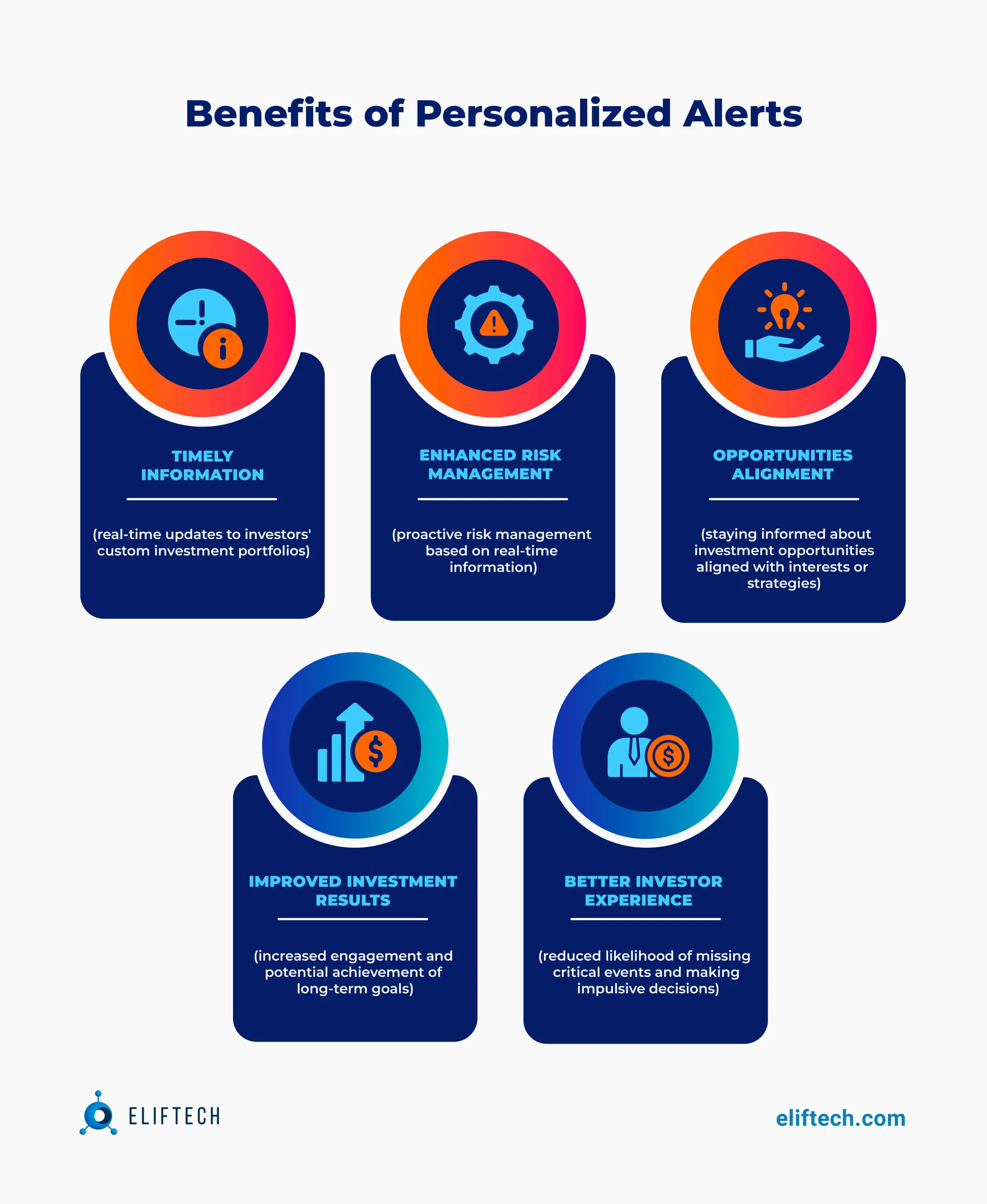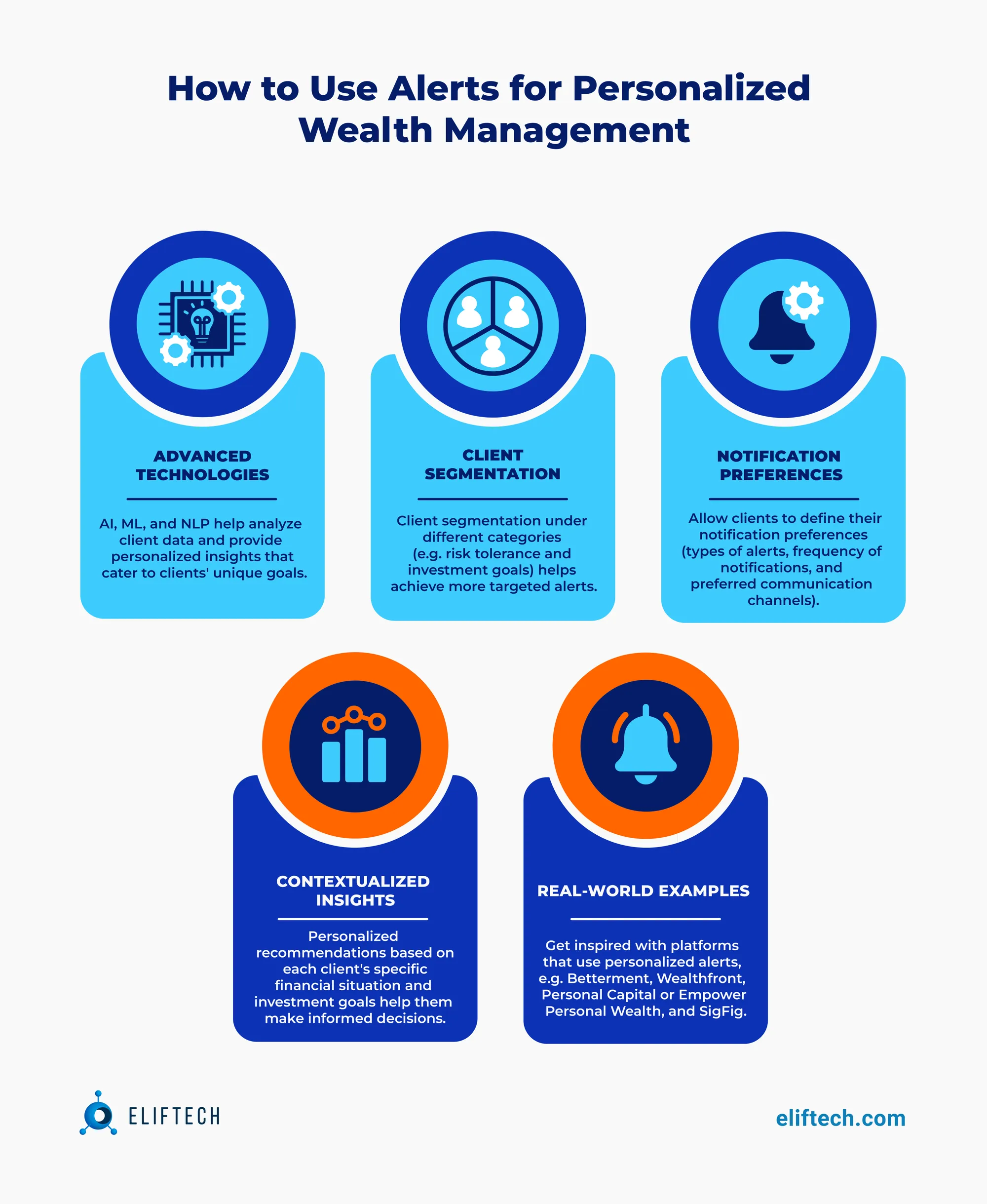Wealth Management
Alerts for Personalized Wealth Management: Enhancing Portfolio Management Experience

Market leaders like Robinhood, Wealthfront, Betterment, and Personal Capital often set the tone for new trends in wealth management apps. This time - it’s real-time alerts for personalized wealth management.
As always, there's a reason behind it: every day, there is a lot of noise in the market, and investment portfolios are becoming more diverse, making it hard for investors to filter that and be aware of changes that may affect them. In the worst-case scenario, one missed alert can cost a fortune and significantly slow investment growth.
That's why personalized alerts for wealth management are crucial today, and it's necessary to have a customized notification system in place to help users manage their assets responsibly.
This article explores how personalized alerts elevate the portfolio management experience, empowering investors to make informed decisions, optimize wealth growth, and navigate financial waters confidently.
The Power of Personalized Alerts in Contributing to Personalized Wealth Management
Understanding how to make wise investment decisions to achieve specific financial goals while managing risk is a whole art. And this is the primary role of independent portfolio management. When it’s done effectively, it ensures the right actions are taken at the right time to achieve the expected results.
In this regard, making wise financial decisions requires effective portfolio management since it helps investors to:
- find suitable investment alternatives that fit their objectives and level of risk tolerance;
- reduce risk by diversifying investments across various assets and sectors;
- increase profits by continuously monitoring market conditions and modifying the portfolio per need;
- maintain a disciplined investing strategy while taking long-term financial goals into account.
Principles of Effective Portfolio Management
To start off, we can characterize effective portfolio management in 7 key principles:
Goal alignment.
Every investor has different expectations, tastes, and ambitions. But how do you ensure a custom investment portfolio is effective for any investor in person? The answer is - through personalization. So, effective portfolio management should include this aspect into account.
A study by McKinsey & Company on personalization shows that it can increase customer satisfaction by 30% and profit by 15%. They have also examined the clients' needs, highlighting personalization as the number-three factor for clients selecting financial products. So, personalization matters and it’s a key driver of client satisfaction.
Diversification.
The allocation of assets among different asset classes, such as stocks, bonds, real estate, and commodities, describes portfolio diversification. It also includes diversifying within each asset class by making investments across a range of businesses, sectors, or geographical areas.
Personalized management involves diversification to reduce the impact of any single investment on the custom investment portfolio. This increases the potential profit and reduces the risk.
Risk management.
In efficient portfolio management, it is very important to assess and control risk. Investors should evaluate their comfort level with risk and ensure that the portfolio's risk matches that level. Strategies like asset allocation, risk-adjusted returns, and stress testing can help investors understand and mitigate potential risks.
Continuous monitoring.
Financial markets are dynamic, and the state of the economy can change quickly. Investors should keep abreast of market changes and make adjustments accordingly. Since the abundance of market information can easily confuse investors, their attention can be easily distracted.
Personalized real-time alerts are a decent solution in this case, as they help filter the information investors would like to pay attention to and be aware of specific market changes relevant to them.
Compliance and security measures.
Adherence to compliance guidelines ensures that the business operates within the law. Thus, your solution should comply with all relevant regulatory requirements in investment and portfolio management, like SEC, FINRA, IOSCO, and similar.
Integration with external accounts.
Integration with other financial tools and platforms, such as banking apps, financial planning software, and tax management systems, provides a holistic view of clients' financial situations, allowing them to make better-informed investment decisions.
Read more: Wealth Management Solutions for Better Investment & Portfolio Management
Interactive reporting and analytics.
An effective portfolio management platform includes comprehensive reporting and analytics tools. Using advanced technologies, businesses can offer easy-to-understand visualizations that enable clients to track their investments' performance and get detailed reports on asset allocation and risk metrics. Interactive charts or performance movers will undoubtedly help better understand their investments and gain useful insights.
Seeking more info on this topic? Read our blog post The Power of Interactive Charts and Performance Movers Feature.
The Power & Benefits of Personalized Alerts
Personalized alerts for wealth management do the same job as Amazon's product suggestions, Netflix's movie recommendations, and Spotify's playlist offerings when it comes to driving consumer loyalty. Personalized alerts are responsible for informing about real-time market changes, fresh news, or price fluctuations based on the chosen preferences of investors.
We can describe their work in two simple steps:
Step 1. Setting up individual criteria.
Investors establish their preferences and criteria for alerts first. This includes identifying the exact events or conditions that trigger alerts. For instance, a stock reaching a certain price level, a portfolio allocation that exceeds a predetermined threshold, or a significant market event affecting their investment.
Step 2. Triggering alerts.
When an event or condition meets the criteria set by the investor, the platform generates and sends a personalized alert to the investor via their preferred communication channel, such as email or mobile notification. The alert may include specific details about the triggering event and any suggested actions or details.

As you can see from the way they work, the first benefit of personalized alerts is timely information. With personalized alerts, investors receive real-time updates to their custom investment portfolios, allowing them to make quick decisions and keep them informed of any changes or potential opportunities affecting their investments.
This advantage flows smoothly into enhanced risk management. Investors can proactively manage the risks associated with their portfolios with real-time information. For example, if the value of an asset declines, an alarm could be triggered, requiring investors to look into the situation and possibly take action to limit losses or rebalance their holdings.
The same happens when investors want to stay informed of the investment opportunities aligned with their interests or strategies. For example, if a particular stock of interest falls below a predetermined price, an alert can be activated, allowing investors to consider buying at a potentially good price.
In addition to improved investment results, personalized alerts give investors a way better experience. Since investors value timely information, it fosters their involvement, leading to increased engagement and the possibility that long-term financial goals will be achieved. With proactive notifications, investors are less likely to miss critical events or make impulsive decisions based on market fluctuations.
How to Achieve Personalized Wealth Management with Alerts?

Financial institutions use various strategies and technologies to achieve personalized wealth management with alerts. Here's how it can be done, along with real-world examples of platforms that have successfully implemented personalized alerts:
- Make use of technology. Personalized wealth management is possible thanks to cutting-edge technologies such as artificial intelligence (AI), machine learning (ML), and natural language processing (NLP). Their algorithms analyze a vast amount of clients’ data and learn from user behavior, preferences, and goals. This data is used to create individual insights, alerts, and recommendations for each client.
Example: Betterment is a robo-advisory platform that provides investing advice and automated notifications using AI-powered algorithms. Based on each client's unique investment profile, the platform notifies them of portfolio rebalancing, tax optimization, and goal progress.
Read more: AI and Machine Learning in Wealth Management: Use Cases & Opportunities - Segment clients. Many financial firms categorize their clients into different groups based on characteristics, including risk tolerance, investment goals, age, and income. This segmentation allows for more targeted alerts that resonate with each group of investors. For example, clients with a higher risk tolerance may receive alerts about more aggressive investment opportunities, while clients with a conservative approach may receive alerts about low-risk investment options.
Example: Another robo-advisor, Wealthfront, divides clients into groups based on things like risk tolerance and financial goals. Then, the software sends individual alerts to each group based on their unique requirements and preferences. - Customize notifications preferences. Platforms offering personalized wealth management allow clients to define their notification preferences. Users can choose their preferred communication channel (email, SMS, mobile app), categories of notifications they want to receive, and message frequency. This flexibility ensures that customers receive alerts according to their preferences and lifestyle.
Example: The Empower personal wealth app allows clients to define their notification preferences, including the types of alerts they wish to receive, the frequency of notifications, and the preferred communication channel. - Provide contextualized insights. Alerts are not limited to basic notifications but can provide contextualized insights and recommendations. Rather than simply informing clients of market events, the platform can provide detailed explanations, analysis, and suggested actions based on each client's specific financial condition and investment goals.
Example: SigFig, a digital wealth management platform, offers information on investment performance, risk management, and portfolio composition, providing clients with detailed analysis to help them make informed decisions.
You can now clearly see how well-known fintech platforms incorporate personalized alerts to enhance independent portfolio management experiences. Using these strategies will allow investors to stay informed, maintain control over their investments, and be better equipped to make well-informed decisions to achieve their financial goals.
Therefore, the more effort you put into improving your clients' investment experience, the more likely they will stay loyal to your particular platform.
Best Practices for Designing Effective Personalized Alert Systems
Creating the right portfolio management style starts with thoughtful design and consideration of the user experience. Businesses should have a clear action plan in place to ensure that the personalized alert system aligns with their users' needs and preferences. Here are some tips and portfolio management best practices to achieve this:
Practice #1. Design the alert system with transparency and simplicity in mind.
Transparency instills confidence and ensures that users understand the relevance of every alert they receive. We recommend you clearly communicate each alert's purpose and the criteria that trigger it. Users should know how the alert system works and what specific events or conditions will prompt notifications.
Simplicity is another attribute of the effective personalized alert system. At ElifTech, we use a minimalist design approach with clean and intuitive interfaces. By having only relevant information in alerts, we allow users to focus on the key details and the actions they need to take.
Practice #2. Make customer expectations a top priority.
Meeting customer expectations enhances user satisfaction and engagement. Two simple ways to achieve it are through extensive user research and feedback analysis.
In the first case, we often interact with consumers through surveys, interviews, or feedback sessions to learn more about their individual alert expectations.
In the second case, we actively take customer feedback into account when making necessary changes to the alert system to meet their needs.
Practice #3. Provide users with a range of customization options.
By offering customization options, customers can receive alerts relevant to their specific financial situation. In personalized alert systems, users should be able to choose the types of alerts they want to receive (e.g., news alerts, price alerts, market updates, etc.) and their preferred communication channels for receiving alerts, such as email, SMS, or push notifications.
Useful tip: Create a custom alert settings menu that allows users to select their preferred alert types and set specific threshold criteria for notifications.
Practice #4. Consider accessibility options
Accessibility options ensure that all users can benefit from the alert system. Ensure the alert system meets accessibility requirements so that people with impairments can use it.
Useful tips from our design team:
- Use color combinations that meet accessibility standards to ensure better readability for users with color vision deficiencies.
- Provide descriptive alternative text for any images or visual elements in the alerts to help users with visual impairments.
- Provide audible notifications to users who might have trouble reading text on screens.
- Ensure the alert system works seamlessly with screen readers, voice assistants, or other assistive technologies commonly used by people with disabilities.
Practice #5. Be mindful of the timing and frequency of alerts.
Positioning a business as customer-centric means you need to respect user preferences and routines. As such, you must allow your users to control the timing and frequency of alerts to avoid overwhelming them. The best solution here is to implement a frequency setting that allows users to choose how often they receive alerts, whether it's daily, weekly, or on a real-time basis. Don't spam people with too many notifications; this can annoy them.
Practice #6. Use visual cues to make alerts engaging
Many users may not have been aware of the benefits of portfolio management they receive through notifications. Thus, your task is to explain to them the additional value that they can receive using the notification system. Visual cues and icons will make personalized alerts easily distinguishable and engaging. We usually use colors, bold fonts, or other formatting techniques to draw attention to different types of alerts.
Practice #7. Provide a cohesive user experience by seamlessly integrating the alert system with your existing portfolio management platform.
Many companies may already have existing portfolio management systems but lack personalized alert systems. In such a scenario, you will need to create an integration framework that seamlessly integrates the alert system and portfolio management platform, providing a unified and user-friendly interface for both systems.
Useful tip: We use APIs and data-sharing protocols to connect the alerts system with an existing platform. This allows seamless data transfer and communication between systems. Also, we create a unified dashboard where users can access both their portfolio information and personalized alerts. This integration will not scatter the attention of users and encourages active use of the notification system.
Practice #8. Improve the alert system continuously
In a digital business environment, effective portfolio management and performance measurement are more important than ever. Organizations will better know what decisions to make in the future if they learn from their previous mistakes.
In this case, businesses should regularly gather user feedback, implement updates over time, and monitor user engagement metrics (e.g., open rates, click-through rates, conversion rates) to track the actual value the alert system delivers and identify pain points they need to address further.
Conclusion
Deciding what assets are best to invest in is a complex science. Some investors may lack specific knowledge in this area, as it requires strong and ongoing education.
We believe businesses should make anything possible to make clients' investments portfolio work best for them. One win-win idea is implementing efficient portfolio management with the tools technology offers today, like personalized real-time alerts.
Examples of well-known wealth management companies showcase how successful this strategy is for both businesses and their clients. They break the barriers of knowledge and empower investors of all backgrounds to navigate the unpredictable tides of the market.
So, if you have any considerations on this matter, we welcome you to engage in a discussion together, helping us craft the ideal personalized wealth management strategy that suits specifically for you.
Get in touch with ElifTech.
